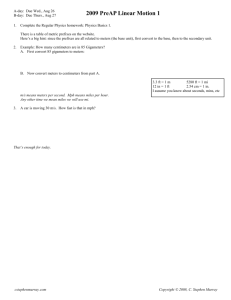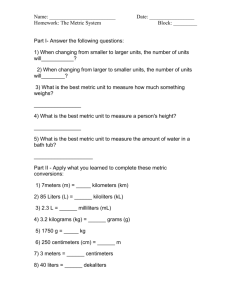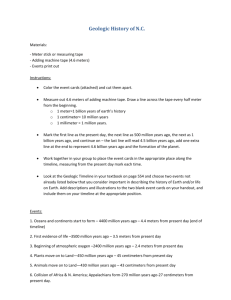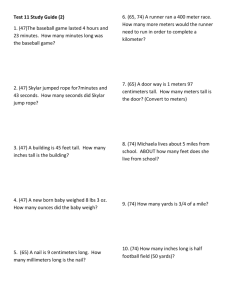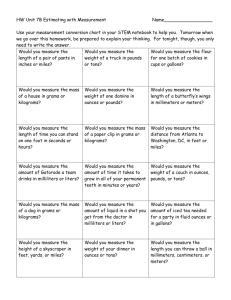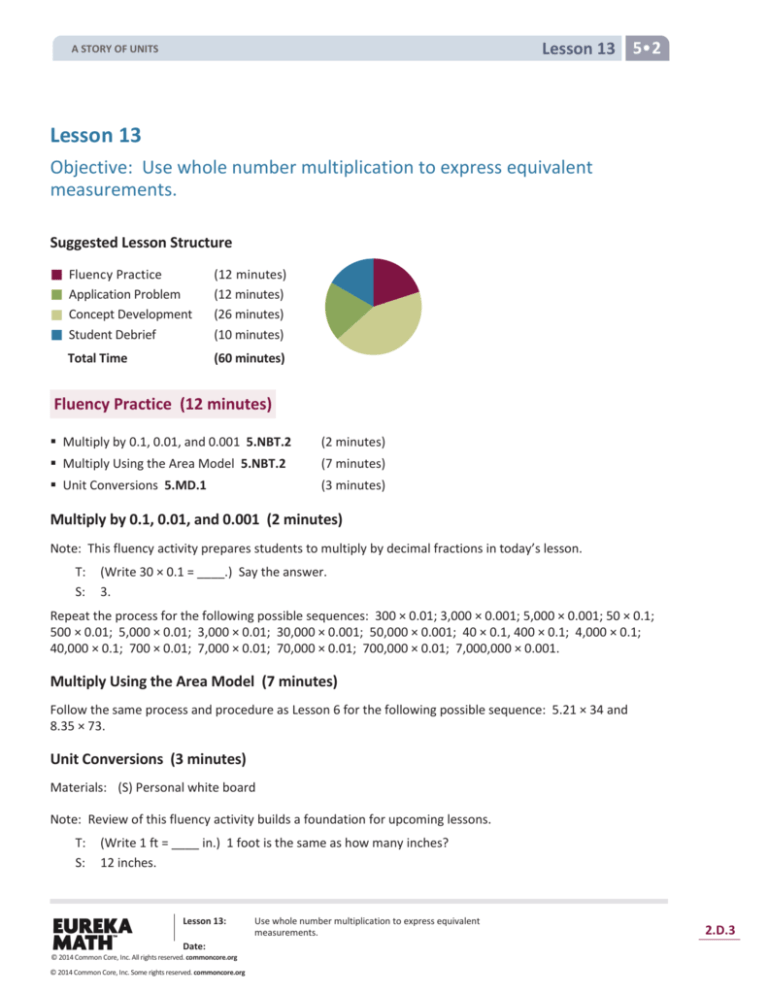
Lesson 13 5•2
A STORY OF UNITS
Lesson 13
Objective: Use whole number multiplication to express equivalent
measurements.
Suggested Lesson Structure
Fluency Practice
Application Problem
Concept Development
Student Debrief
Total Time
(12 minutes)
(12 minutes)
(26 minutes)
(10 minutes)
(60 minutes)
Fluency Practice (12 minutes)
Multiply by 0.1, 0.01, and 0.001 5.NBT.2
(2 minutes)
Multiply Using the Area Model 5.NBT.2
(7 minutes)
Unit Conversions 5.MD.1
(3 minutes)
Multiply by 0.1, 0.01, and 0.001 (2 minutes)
Note: This fluency activity prepares students to multiply by decimal fractions in today’s lesson.
T:
S:
(Write 30 × 0.1 = ____.) Say the answer.
3.
Repeat the process for the following possible sequences: 300 × 0.01; 3,000 × 0.001; 5,000 × 0.001; 50 × 0.1;
500 × 0.01; 5,000 × 0.01; 3,000 × 0.01; 30,000 × 0.001; 50,000 × 0.001; 40 × 0.1, 400 × 0.1; 4,000 × 0.1;
40,000 × 0.1; 700 × 0.01; 7,000 × 0.01; 70,000 × 0.01; 700,000 × 0.01; 7,000,000 × 0.001.
Multiply Using the Area Model (7 minutes)
Follow the same process and procedure as Lesson 6 for the following possible sequence: 5.21 × 34 and
8.35 × 73.
Unit Conversions (3 minutes)
Materials: (S) Personal white board
Note: Review of this fluency activity builds a foundation for upcoming lessons.
T:
S:
(Write 1 ft = ____ in.) 1 foot is the same as how many inches?
12 inches.
Lesson 13:
Date:
© 2014 Common Core, Inc. All rights reserved. commoncore.org
© 2014 Common Core, Inc. Some rights reserved. commoncore.org
Use whole number multiplication to express equivalent
measurements.
2.D.3
Lesson 13 5•2
A STORY OF UNITS
Repeat the process for the following possible sequence: 2 ft, 3 ft, 4 ft, 10 ft, 5 ft, 7 ft.
T:
S:
(Write 100 cm = ____ m.) 100 centimeters is the same as how many meters?
1 meter.
Repeat the process for the following possible sequence: 200 cm, 300 cm, 600 cm, 800 cm, 900 cm.
Application Problem (12 minutes)
Materials: (S) Meter strip (Template), one string either 9 cm, 20 cm,
75 cm, or 105 cm
Procedure: Pass out a string to each student so that partners have
different length strings. Have them measure their strings and
express the measurement in meters, centimeters, and millimeters,
as well as share their measurements with their partners. Record the
measurements of the strings in a class chart and revisit the following
concepts from Lesson 4:
m
cm
mm
A
1.05 m
105 cm
1,050 mm
B
0.75 m
75 cm
750 mm
C
0.2 m
20 cm
200 mm
Although the number of units has changed, the length of D 0.09 m
9 cm
90 mm
the string is the same.
1.05 meters × 103 = 1,050 meters. This equation makes
1,000 copies of 1.05 meters.
To convert meters to millimeters, we multiply the number of meters by 103. 1.05 × 103 = 1,050 to
find that 1.05 meters = 1,050 millimeters.
Note: Today’s Application Problem provides a practical, hands-on way for students to experience the
conversion reasoning foundational to today’s lesson.
Concept Development (26 minutes)
Materials: (S) Meter strip (Template), personal white board
Problem 1
3 weeks = ____ days
3 weeks = 3 × (1 week)
= 3 × (7 days)
= 21 days
T:
S:
T:
(Write 3 weeks = 3 × (1 week) on the board.) Explain to your partner why this is true.
3 weeks is the same as 3 units of 1 week. It’s 3 groups of 1 week. It’s like last year we saw that
3 fourths is the same as 3 times 1 fourth
What are the two factors?
Lesson 13:
Date:
© 2014 Common Core, Inc. All rights reserved. commoncore.org
© 2014 Common Core, Inc. Some rights reserved. commoncore.org
Use whole number multiplication to express equivalent
measurements.
2.D.4
Lesson 13 5•2
A STORY OF UNITS
S:
T:
S:
T:
T:
T:
S:
T:
S:
T:
T:
S:
T:
S:
3 and 1 week.
How many days are equal to 1 week?
7 days.
So rename 1 week as 7 days.
Let’s use parentheses to make it clear that this factor, or conversion factor, has the same value.
(Write 3 × (7 days) directly below 3 × (1 week), so that the equivalence of the two factors is very
clear.)
3 times 7 days is how many days?
21 days.
So 3 weeks equals how many days?
21 days.
On your personal white board, take a moment to convert 3 hours
to minutes using the same process. Remember to use the
3 hours = ____ minutes
parentheses to clarify the renaming of the conversion factor.
3 hours = 3 (1 hour)
Review your conversion with your partner.
= 3 (60 minutes)
(After students’ work.) We converted 3 hours to 180 minutes.
Did we convert from a larger unit to a smaller unit or a smaller
= 180 minutes
unit to a larger unit?
Larger to smaller.
Yes. An hour is a larger unit than a minute. Since we converted to a smaller unit, a minute, what
happened to the amount of time?
There are more units but the exact same amount of time. The number of units increased, but the
time stayed the same.
Problem 2
1.05 m = ____ cm
1.05 m = 1.05 × (1 m)
= 1.05 × (100 cm)
= 105 cm
T:
T:
S:
T:
S:
T:
S:
(Write 1.05 m on the board.) Let’s use the same strategy to convert larger units to smaller units,
starting with the conversions from our Application Problem.
Let’s convert 1.05 meters to centimeters. First, let’s rename 1.05 meters as a multiplication
expression. Consider how we expressed 3 weeks as an expression. Talk to your partner.
One factor is 1.05, and the other factor is 1 meter. 1.05 × 1 meter.
(Write 1.05 m = 1.05 × (1 m).) Let’s rename the conversion factor in centimeters. 1 meter equals…?
100 centimeters.
(Write 1.05 m = 1.05 × (100 cm).) What is 1.05 times 100 centimeters?
105 centimeters.
Lesson 13:
Date:
© 2014 Common Core, Inc. All rights reserved. commoncore.org
© 2014 Common Core, Inc. Some rights reserved. commoncore.org
Use whole number multiplication to express equivalent
measurements.
2.D.5
Lesson 13 5•2
A STORY OF UNITS
T:
Is that the correct conversion? Does 1.05 meters equal 105 centimeters? (Hold up the meter strip,
and refer to the chart from the Application Problem.)
Have students convert other string measurements: 0.75 meters, 0.2 meters, and 0.09 meters to centimeters
and then millimeters using the strategy.
0.09 m = ____ cm
0.09 m = ____ mm
0.09 m = 0.09 × (1 m)
0.09 m = 0.09 × (1 m)
= 0.09 × (100 cm)
= 0.09 × (1,000 mm)
= 9 cm
= 90 mm
Problem 3
A crate of apples weighs 5.7 kilograms. Convert the weight to grams.
A sack holds 56.75 pounds of sand. Convert the weight to ounces.
T:
Start the process with the students. Write the measurement as an equivalent expression with the unit as
a factor.
5.7 kg = ____ g
56.75 lb = ____ oz
5.7 kg = 5.7 × (1 kg)
56.75 lb = 56.75 × (1 lb)
= 5.7 × (1,000 g)
= 56.75 × (16 oz)
= 5,700 g
= 908 oz
Problem Set (10 minutes)
Students should do their personal best to complete the Problem Set within the allotted 10 minutes. For
some classes, it may be appropriate to modify the assignment by specifying which problems they work on
first. Some problems do not specify a method for solving. Students should solve these problems using the
RDW approach used for Application Problems.
Lesson 13:
Date:
© 2014 Common Core, Inc. All rights reserved. commoncore.org
© 2014 Common Core, Inc. Some rights reserved. commoncore.org
Use whole number multiplication to express equivalent
measurements.
2.D.6
Lesson 13 5•2
A STORY OF UNITS
Student Debrief (10 minutes)
Lesson Objective: Use whole number multiplication to
express equivalent measurements.
The Student Debrief is intended to invite reflection and
active processing of the total lesson experience.
Invite students to review their solutions for the Problem
Set. They should check work by comparing answers with a
partner before going over answers as a class. Look for
misconceptions or misunderstandings that can be
addressed in the Debrief. Guide students in a conversation
to debrief the Problem Set and process the lesson. You
may choose to use any combination of the questions below
to lead the discussion.
In the conversion you completed for Problem 1(d),
explain your process as you worked. How did you
decide what to multiply by?
Although we multiplied by 100 to convert 1.05
meters to 105 centimeters, the length remained
the same. Why?
Explain the term conversion factor. (The
conversion factor is the factor in a multiplication
sentence that renames one measurement unit as
another equivalent unit.) For example,
14 × (1 in) = 14 × ( ft), 1 in and ft are the
conversion factors.
What would be the conversion factor if we wanted
to convert years to days? Years to months? Why
isn’t there one conversion factor to convert
months to days? Why isn’t there one conversion
factor to convert years to days?
Can you name some situations in which
measurement conversion might be useful and/or
necessary?
Exit Ticket (3 minutes)
After the Student Debrief, instruct students to complete
the Exit Ticket. A review of their work will help you assess
the students’ understanding of the concepts that were
presented in the lesson today and plan more effectively for
future lessons. You may read the questions aloud to the students.
Lesson 13:
Date:
© 2014 Common Core, Inc. All rights reserved. commoncore.org
© 2014 Common Core, Inc. Some rights reserved. commoncore.org
Use whole number multiplication to express equivalent
measurements.
2.D.7
Lesson 13 Problem Set 5•2
A STORY OF UNITS
Name
Date
1. Solve. The first one is done for you.
a. Convert weeks to days.
b. Convert years to days.
8 weeks = 8 × (1 week)
4 years = ___________ × ( ___________ year)
= 8 × (7 days)
= ___________ × ( ___________ days)
= 56 days
= ___________ days
c. Convert meters to centimeters.
d. Convert yards to feet.
9.2 m = ___________ × ( ___________ m)
5.7 yards
= ___________ × ( ___________ cm)
= ___________ cm
e. Convert kilograms to grams.
6.08 kg
f.
Convert pounds to ounces.
12.5 pounds
Lesson 13:
Date:
© 2014 Common Core, Inc. All rights reserved. commoncore.org
© 2014 Common Core, Inc. Some rights reserved. commoncore.org
Use whole number multiplication to express equivalent
measurements.
2.D.8
Lesson 13 Problem Set 5•2
A STORY OF UNITS
2. After solving, write a statement to express each conversion. The first one is done for you.
a. Convert the number of hours in a day to
minutes.
b. A small female gorilla weighs 68 kilograms.
How much does she weigh in grams?
24 hours = 24 × (1 hour)
= 24 × (60 minutes)
= 1,440 minutes
One day has 24 hours, which is the same as
1,440 minutes.
c. The height of a man is 1.7 meters. What is
his height in centimeters?
d. The capacity of a syringe is 0.08 liters. Convert
this to milliliters.
e. A coyote weighs 11.3 pounds. Convert the
coyote’s weight to ounces.
f.
Lesson 13:
Date:
© 2014 Common Core, Inc. All rights reserved. commoncore.org
© 2014 Common Core, Inc. Some rights reserved. commoncore.org
An alligator is 2.3 yards long. What is the length
of the alligator in inches?
Use whole number multiplication to express equivalent
measurements.
2.D.9
Lesson 13 Exit Ticket 5•2
A STORY OF UNITS
Name
Date
1. Solve.
a. Convert pounds to ounces.
(1 pound = 16 ounces)
b. Convert kilograms to grams.
14 pounds = _________ × (1 pound)
= _________ × ( _________ ounces)
= _________ ounces
Lesson 13:
Date:
© 2014 Common Core, Inc. All rights reserved. commoncore.org
© 2014 Common Core, Inc. Some rights reserved. commoncore.org
18.2 kilograms = _________ × ( _________ )
= _________ × ( _________ )
= _________ grams
Use whole number multiplication to express equivalent
measurements.
2.D.10
Lesson 13 Homework 5•2
A STORY OF UNITS
Name
Date
1. Solve. The first one is done for you.
a. Convert weeks to days.
b. Convert years to days.
6 weeks = 6 × (1 week)
7 years = ___________ × ( ___________ year)
= 6 × (7 days)
= ___________ × ( ___________ days)
= 42 days
= ___________ days
c. Convert meters to centimeters.
d. Convert pounds to ounces.
4.5 m = ___________ × ( ___________ m)
12.6 pounds
= ___________ × ( ___________ cm)
= ___________ cm
e. Convert kilograms to grams.
3.09 kg
f.
Convert yards to inches.
245 yd
Lesson 13:
Date:
© 2014 Common Core, Inc. All rights reserved. commoncore.org
© 2014 Common Core, Inc. Some rights reserved. commoncore.org
Use whole number multiplication to express equivalent
measurements.
2.D.11
Lesson 13 Homework 5•2
A STORY OF UNITS
2. After solving, write a statement to express each conversion. The first one is done for you.
a. Convert the number of hours in a day to
minutes.
b. A newborn giraffe weighs about 65 kilograms.
How much does it weigh in grams?
24 hours = 24 × (1 hour)
= 24 × (60 minutes)
= 1,440 minutes
One day has 24 hours, which is the same as
1,440 minutes.
c. The average height of a female giraffe is 4.6
meters. What is her height in centimeters?
d. The capacity of a beaker is 0.1 liter. Convert this
to milliliters.
e. A pig weighs 9.8 pounds. Convert the pig’s
weight to ounces.
f.
Lesson 13:
Date:
© 2014 Common Core, Inc. All rights reserved. commoncore.org
© 2014 Common Core, Inc. Some rights reserved. commoncore.org
A marker is 0.13 meters long. What is the length
in millimeters?
Use whole number multiplication to express equivalent
measurements.
2.D.12
meter strip
© 2014 Common Core, Inc. All rights reserved. commoncore.org

